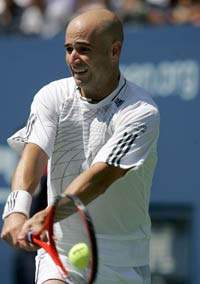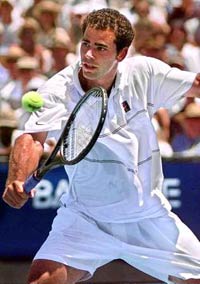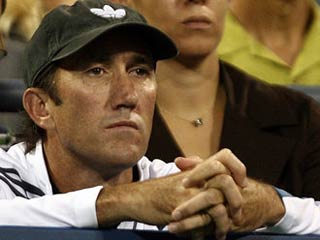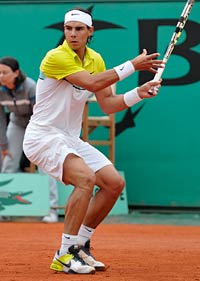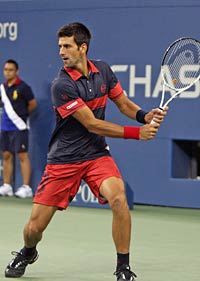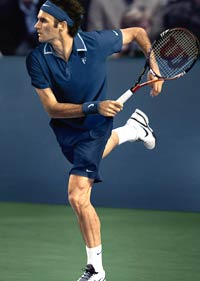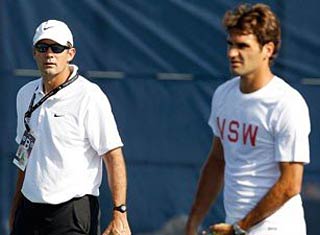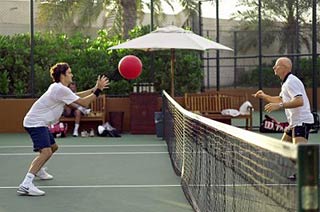|
TennisOne Lessons How Will Roger Federer Fare In 2012? Paul Fein "Watching Federer is like watching Mikhail Baryshnikov. I watch with a lot of respect and a little envy." — John McEnroe, 1980s superstar In the past 20 years only legends Pete Sampras and Andre Agassi have captured a Grand Slam singles title at the ancient tennis age of 30 or more. During first 24 years of Open Tennis, 15 men equally long in the tooth achieved the feat. As athletes have become bigger, stronger and faster, defying Father Time has become harder than ever in a pro sport that requires and rewards supreme athleticism.
If anyone can overcome the odds, though, it’s Roger Federer. The incomparable Swiss, who turned 30 on August 8, boasts a record 16 major singles titles and is widely acclaimed as the GOAT (greatest of all time). Some authorities, like ESPN analyst Darren Cahill, believe Federer is not only getting older, he’s getting better. If that’s true, why hasn’t Federer won a Grand Slam title since the 2010 Australian Open? And will he, like Sampras and Agassi, enjoy a last hurrah in the twilight of his celebrated career? In 2012, Federer will have a golden opportunity to capture a big title—in fact, five chances—because the tennis event at the London Olympics will be staged at Wimbledon on grass, his best surface. While “The Mighty Fed” owns a career Grand Slam, he’s never turned in an Olympian singles performance at the Games, reaching only the second round at Athens and quarterfinals at Beijing. When Cahill reviews the 2011 season, he believes that at the majors—aside from the Australian Open where Federer was clearly outplayed by Novak Djokovic—Federer showed he still has the right stuff. “At the French Open he played the best clay court tennis of his career,” says Cahill, a former Australian Davis Cupper. “It wasn’t just in the semifinals when he beat Novak; it was throughout the entire tournament. He was taking everybody apart throughout that tournament. He was serving incredibly well. He was exploding on his forehand. He was moving beautifully. His backhand was rock solid. And he proved that by having that great victory over Novak and getting through to the final. “His final against Nadal was one of the most competitive clay court matches those two have played,” says Cahill. “In tennis it’s [sometimes] five or six points where you look back and you say, “There was really a turning point there. Obviously, that drop shot Federer played [and missed by an inch] on set point was crucial. Had he grabbed the first set, we may have seen a different result. But that’s how it goes, and Nadal turned out being too good in the end. From a clay court perspective, Federer showed long periods of sustained great tennis. And that was on his worst surface.”
Before six-time champion Federer was upset 3-6, 6-7, 6-4, 6-4, 6-4 by 12th-seeded Jo-Wilfried Tsonga in the Wimbledon quarterfinals, he had amassed 178 straight victories after winning the first two sets in Grand Slam matches. Although Tsonga played better on the crucial points, Federer said, “It was a great match from both sides”; and his 57 winners against only 11 unforced errors supported that as did Tsonga’s 63 winners offset by just 22 unforced errors. “At Wimbledon he was completely taken by surprise with the quality of tennis Tsonga played during the last three sets,” says Cahill. “After Federer led two sets to love, maybe he just took his foot off the gas slightly.” History repeated itself in an eerie fashion for Federer at the US Open where, for the second year in a row, nemesis Djokovic escaped two match points in a five-set semifinal to prevail. Cahill considers that shot-making thriller another encouraging sign for Federer in 2012, and says, “He has a real chance of winning four of the five biggest tournaments [including the Olympics]. It will be tougher at Roland Garros where you still have the lefty Nadal there. Wimbledon is his best chance. The Olympics on the grass at Wimbledon give him a double chance on his best surface. He’s won it so many times before. Wimbledon gives him a pretty special feeling. He’s going to be a tough guy for anyone to beat in the semis or in the final there.” Federer’s Main Rivals Although Federer’s 16 career majors far outdistance Nadal’s 10 (plus an Olympic gold medal in Beijing), Djokovic’s four and Murray’s none, his head-to-head records with his three main rivals tell quite a different story. Nadal leads him 17-8 overall, including a 3-0 record this year, and Murray is ahead 8-6. Djokovic trails 14-10 but grabbed four of five matches against Federer in 2011. Significantly, Federer and Djokovic have faced each other in seven major semifinals during the past four years, and that difficult semifinal matchup may continue in 2012 with Djokovic now ranked No. 1 and Federer at No. 4.
Nonetheless, Cahill thinks Federer can turn his rivalry with the surging Serb around. “Federer says he’s not overly concerned that Novak has beaten him four out of five times this year because most of those matches have been incredibly competitive,” says Cahill. “He feels like if he goes out there and executes his game, he doesn’t have to change much when it comes to the Djokovic matchup. He’s right there with Novak. His game matches up pretty well with Novak. It’s the Nadal matchup that’s always been a problem for Federer. “Matchups are a funny thing in the world of tennis where it’s one on one,” explains Cahill, a former coach of world No. 1s Andre Agassi and Lleyton Hewitt. “With the top three players at the moment, Federer prefers the Djokovic matchup, and Djokovic prefers the Nadal matchup, and Nadal prefers the Federer matchup. It’s been a Rubik’s Cube [like-problem] to work out for Federer against Nadal. Slowly but surely Federer has been getting better at it on his worst surface, but Nadal’s ability to get the ball bouncing high to Federer’s backhand will always make it a problem. It’s a problem for every single-handed player facing Nadal.” “At Roger’s age, the only difference you would say from when he was 22 is that ever so slightly he has lost a little bit of speed,” says Cahill. “And he can lose a little bit of speed because he’s so phenomenally fast to start with. He’s made adjustments in other areas. Early in his career, he was a serve-and-volley player and liked to get to the net. And then all of a sudden he realized he didn’t have to rush things, and he played from the baseline and used his defensive game and waited for the right ball to explode on the first forehand that sits up there for him and take over the point. He made an incredible adjustment with that.” Federer’s evolution continued later in the decade to meet the far greater challenges Nadal and Djokovic posed. “Against his rivals, like Roddick and Hewitt, he stopped serving and volleying and he realized those guys couldn’t really hurt him from the backcourt and he could wait for his chance to attack. But now, with players like Djokovic and Nadal, he’s going to adjust a little bit because those guys can hurt him,” explains Cahill “They have the power and the weight of shot that can get Roger behind the 8-ball. It’s okay to play defensive tennis [sometimes], but you still need to be in control of things. Against Novak and Rafa, he’s not in control when he has to defend a lot. So he’s made the adjustments to be a little more offensive with the forehand. He’s looking to hit his backhand down the line a little earlier in the points now. He’s also coming in a little more now—not much serving and volleying—but off bigger groundstrokes.
“Federer’s down-the-line backhand is not a weapon, but it’s a set-up shot because more than likely, after he hits his backhand down the line, the next ball he’s going to get is a forehand,” says Cahill. “It makes his backhand side of the court become that much smaller to his opponent. If Federer plays his backhand to the middle of the court or crosscourt to Nadal, it’s pretty easy to get the next shot to Roger’s backhand. But if Federer hits a big backhand down the line, Nadal has to get there and guide his backhand down the line, and it’s not easy to get that next shot to Roger’s backhand. So it’s more of a set-up shot for his forehand. Whereas, a few years ago, he didn’t have to go to that shot early in the point. Now he does because he’s looking to control more points with his forehand. “His backhand down the line is not a comfortable shot for Federer or any guy with a single-handed backhand,” continues Federer. “It’s the most difficult shot to play because you’re going over the high part of the net and you can’t generate as much topspin on the ball so to get the ball back down into the court is not as easy, and you’re hitting against the grain—the ball is normally coming crosscourt toward you and hitting on the inside of the ball trying to change the direction of the oncoming ball. It’s not a natural shot. It’s much easier to return the ball crosscourt. So you have to force yourself out of your comfort zone a little bit to get the next shot on your strength. That’s what you’re seeing Roger do more of.” Vital Statistics During 2011 Federer’s service return, particularly on his backhand side, declined noticeably. He’s won only 27% of return games this year compared to 36% for Nadal and 41% for Djokovic. Against Djokovic, Federer won only 26% of first serve return points at the Australian and an abysmal 17% at the US Open. Finally, he’s converted only 14 of 51 break chances against Djokovic and only 7 of 28 against Nadal. Cahill believes these statistics reveal an area Federer must improve to win a major next year, but he is quick to put them into perspective. “Roger’s return has never been a strength like an Agassi return or a Berdych return or a Safin return, where they actually step up there and crack the ball and try to get on the offense straightaway,” notes Cahill. “Roger just never missed. He would use that slice backhand return very effectively. He has long arms and would get his racket on a lot of balls. That’s why Roddick had so many problems against him. He was a big server but it was tough to ace Roger because he had good anticipation and a great stretch. He would only block the ball back and then use his defensive skills to get into the point. Federer didn’t feel like those guys could really hurt him from the back of the court. He could get away with a chip return down the middle of the court, knowing that he was going to stay in the point. Now he can’t because Nadal and Djokovic, and to a lesser extent, Murray, are going to hurt him. Berdych and Tsonga are also going to attack his return and hurt him. If you chip the ball down the middle of the court, they’re going to run around and crack a forehand and dominate the point straightaway.” This natural evolution forced Federer to change the way he returns serve. “He has to be a little more aggressive, use more power and add topspin on the backhand more often. But with that aggression comes a few more errors,” points out Cahill. “Federer is trying to make a difference on those big points. Variety is the key for Roger’s return of serve. But, more important, he has to be aggressive at the right time. Most of these great players, when they’re down and feel their backs are against the wall, play offensive tennis. They don’t let you control the point. That’s where Roger gets himself in trouble at times. When he does get a lot of those break points, he’s been content to chip his return of serve back into play, and Nadal and Djokovic are going to run around [their backhands] and be overly offensive and not give you a chance to take that point away from them. That’s where you’re seeing Roger being a little more aggressive on those big points. Sometimes it’s paid off, sometimes it hasn’t. But, in the long term, that’s the right tactic for him.”
Cahill believes Federer has the right team in his corner to continue making smart adjustments as his career evolves. Team Federer consists of Paul Annacone, who coached Sampras during the second half of his storied career, Swiss Davis Cup captain Severin Luthi, ATP World Tour trainer Stephane Vivier and fitness trainer Pierre Paganini. “The hiring of Paul Annacone [as coach] was a great move. And Severin Luthi is a wonderful guy who knows a lot more about tennis than people give him credit for,” says Cahill. “Federer is making the right changes: being a little more offensive on the big points and exploding on more forehands and not trying to over-serve against the top players, and serving more consistently closer to the lines, and keeping that first-serve percentage high. He’s gotten himself into trouble against some of the better returners by trying to serve too big and looking for those free points—but he knows that placing the ball a couple of inches from the service line and then using his speed to be offensive and hit a forehand on his first shot is more his game than is trying to out-serve somebody.
“The very undervalued and under-written-about person in the Federer camp is his fitness trainer who has done an incredible job for Federer,” says Cahill. “Pierre Paganini has been with him for a long time and has been extremely loyal, and they do a great amount of work off the court—a lot of it behind closed doors. He has been able to keep Roger’s body in tip-top shape to maintain the speed and stamina we see on the court. And he’s been able to keep him injury-free to the point where Federer hasn’t retired during a match throughout his pro career. Your body is your biggest asset, and if you don’t look after your body, it’s going to let you down. If you do look after it, it will reward you with great things. So that is the No. 1 asset for him. “Roger has always been an extremely hard worker,” adds Cahill. “In those few days I spent in Dubai with Roger, it was bloody hot and he was on the court four hours a day grinding and then doing his off-court work with his fitness trainer. You don’t get to be as good as Roger Federer without putting in some pretty brutal training throughout the course of his career. He’s done it the right way. He’s earned it. “I wouldn’t give Roger any other advice than he’s getting because he’s on the right path, and you’ve seen the level of his play improve in the last couple of years. I would say very confidently he’s a better player than he was two years ago,” says Cahill. “You become that by continuing to work on your strengths and managing where you feel like you’re getting let down in the big matches. When I saw Federer play Novak at the US Open and Novak and Rafa at the French Open, you can see those subtle changes in his game and also see more belief in what he’s trying to accomplish. “Four or five years ago, he was swinging around in the wind, really not knowing what to do against Nadal on clay, he had no idea what the game plan was, how big he should serve, which side he should be attacking, how much he should be coming to the net,” explains Cahill. “He was getting blown away by Nadal. Now there is a real sense of purpose when he goes on the court against him on Nadal’s best surface.” Passion for Tennis Unlike Sampras who recently told CBS Los Angeles he didn’t miss being ranked No. 1 (during 1993-’98) because “it comes with stress—tennis is a tough sport,” Federer says, “I’m still as hungry. It [being 30] is just a number.” In fact, now he’s drawing inspiration from a new source. “Like Agassi, Jimmy Connors, Ken Rosewall, Rod Laver, it’s very inspiring to see what they were able to do for a very long period of time.”
Cahill contends Federer’s passion for the sport is one of his most important assets: “You can’t put a value on having a love of the game, having a great respect for the game. And for Roger, feeling like he wants to continue at this level for the next three or four or five years, it gives him the desire to go out there and practice every day and try to get better every day. It gives him purpose.” The Federer legacy extends far beyond his extraordinary records, sublime on-court artistry and sportsmanship (he received the Edberg Sportsmanship Award a record six times). His ever-growing charity foundation sponsors education and sports projects in Ethiopia, South Africa, Switzerland, Tanzania, Zimbabwe and Malawi, where in June it launched an ambitious $8.45 million program to support early childhood education for 54,000 children over the next ten years. Not surprisingly, The Reputation Institute ranked Federer second—behind only former South African president Nelson Mandela—when this year it polled 51,000 people in 25 countries, asking them to measure whether the world’s most visible leaders are liked, respected and trusted. “He’s done it in a fashion that’s been nothing but class. It’s been easy to have great respect for him,” says Cahill. “You look at every sport, and for the sport to move ahead, you need great leaders. In today’s era, with Federer, Nadal, and Djokovic, these guys are great examples for how to lead any sport, not just tennis. They speak highly about the sport, they give it their all, and they travel the world as great ambassadors. They have great respect for the sport, not only for the era they’re playing in but also for the eras of the past. Roger epitomizes that. Tennis is very, very fortunate to have him.” How much longer tennis will have him may depend on how he fares in 2012. “Nadal, Djokovic, and even Murray have improved the top level of tennis to a point we’ve never seen before,” says Cahill. “If I were betting on whether Federer would win zero, one or two major titles next year, I would lay a bet on one title. With the way Djokovic has dominated this year, it’s all set up for a really fascinating 2012.” Your comments are welcome. Let us know what you think about Paul Fein's article by emailing us here at TennisOne.
Paul Fein Paul Fein has received more than 30 writing awards and authored three books, Tennis Confidential: Today’s Greatest Players, Matches, and Controversies, You Can Quote Me on That: Greatest Tennis Quips, Insights, and Zingers, and Tennis Confidential II: More of Today’s Greatest Players, Matches, and Controversies. Fein is also a USPTA-certified teaching pro and coach with a Pro-1 rating, former director of the Springfield (Mass.) Satellite Tournament, a former top 10-ranked men’s open New England tournament player, and formerly a No. 1-ranked Super Senior player in New England. |
|||||||||||
